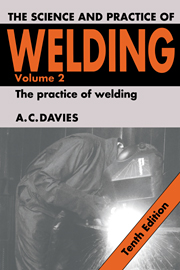Book contents
- Frontmatter
- Contents
- Preface
- 1 Manual metal arc welding
- 2 Gas shielded metal arc welding
- 3 Tungsten electrode, inert gas shielded welding processes (TIG), and the plasma arc process
- 4 Resistance welding and flash butt welding
- 5 Additional processes of welding
- 6 Oxy-acetylene welding
- 7 Cutting processes
- 8 The welding of plastics
- Appendixes
- City and Guilds of London Institute examination questions
- Index
- Frontmatter
- Contents
- Preface
- 1 Manual metal arc welding
- 2 Gas shielded metal arc welding
- 3 Tungsten electrode, inert gas shielded welding processes (TIG), and the plasma arc process
- 4 Resistance welding and flash butt welding
- 5 Additional processes of welding
- 6 Oxy-acetylene welding
- 7 Cutting processes
- 8 The welding of plastics
- Appendixes
- City and Guilds of London Institute examination questions
- Index
Summary
Gas cutting of iron and steel
Iron and steel can be cut by the oxy-hydrogen, oxy-propane, oxy-natural gas and oxy-acetylene cutting blowpipes with ease, speed and a cleanness of cut.
Principle of cutting operation
There are two operations in gas cutting. A heating flame is directed on the metal to be cut and raises it to bright red heat or ignition point. Then a stream of high-pressure oxygen is directed on to the hot metal. The iron is immediately oxidized to magnetic oxide of iron (Fe3O4) and, since the melting point of this oxide is well below that of the iron, it is melted immediately and blown away by the oxygen stream.
It will be noted that the metal is cut entirely by the exothermic chemical action and the iron or steel itself is not melted. Because of the rapid rate at which the oxide is produced, melted and blown away, the conduction of the metal is not sufficiently high to conduct the heat away too rapidly and prevent the edge of the cut from being kept at ignition point.
The heat to keep the cut going once it has started is provided partly by the heating jet, and partly by the heat of the chemical action.
The cutting torch or blowpipe (Fig. 7.1)
Cutting blowpipes may be either high or low pressure. The high pressure pipe, using cylinder acetylene or propane as the fuel gas,* can have the mixer in the head (Fig. 7.2), or in the shank, while the low pressure pipe with injector mixing can be used with natural gas at low pressure.
- Type
- Chapter
- Information
- The Science and Practice of Welding , pp. 326 - 355Publisher: Cambridge University PressPrint publication year: 1993

